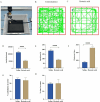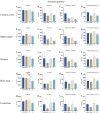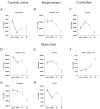Preliminary study on the time-correlation changes in brain neurotransmitters of mice exposed to mushroom toxin ibotenic acid
- PMID: 40529243
- PMCID: PMC12171373
- DOI: 10.3389/fnins.2025.1561291
Preliminary study on the time-correlation changes in brain neurotransmitters of mice exposed to mushroom toxin ibotenic acid
Abstract
Background: Mushroom poisoning represents a significant food safety issue globally, particularly neurotoxic mushroom poisoning, which raises considerable concern due to its potential to induce central nervous system symptoms. Ibotenic acid is identified as the primary neurotoxin associated with this form of poisoning; however, the underlying mechanisms of its neurotoxicity remain poorly understood.
Objective: This study aims to systematically evaluate the effects of ibotenic acid exposure across three consecutive key time points, from intoxication to recovery, on neurotransmitters related to the GABA/Glutamic-Acid, dopaminergic, serotonergic, and cholinergic systems in five brain regions: the cerebral cortex, hippocampus, striatum, brain stem, and cerebellum.
Methods: Through behavioral tests, we assessed the effects of ibotenic acid exposure on voluntary activities and learning and memory functions in mice. Additionally, we analyzed the changes in neurotransmitter concentrations across different brain regions using targeted metabolomics.
Results: Behavioral results indicated that the total movement distance and speed in the open field test were significantly reduced, while the resting time was prolonged in the ibotenic acid-exposed group (P < 0.0001). The results of targeted metabolomics demonstrated that, compared to the control group, levels of glutamic acid in the hippocampus and brain stem significantly decreased after 4 h of ibotenic acid exposure (P < 0.05, P < 0.001). Additionally, epinephrine levels in the cerebral cortex decreased at 20 min (P < 0.05), while tyrosine levels in the brain stem and cerebellum decreased after 4 h (P < 0.05). In the brain stem region, the tryptophan levels in each exposure group decreased significantly compared with the 4-h exposure group (P < 0.01), and brain stem choline levels significantly decreased (P < 0.05). Conversely, homovanillic acid levels in the brain stem increased (P < 0.01).
Conclusion: Preliminary studies have demonstrated that acute exposure to ibotenic acid inhibits motor activity but does not significantly affect learning and memory in mice. Exposure to ibotenic acid induces alterations in GABA/Glutamic-Acid, dopaminergic, serotonergic, and neurotransmitters associated with the cholinergic system in the brains of mice, with the most pronounced changes occurring in the brain stem region, exhibiting time-dependent and region-specific effects. This study offers new insights into the neurotoxic mechanisms of ibotenic acid.
Keywords: ibotenic acid; metabolomics; neurotoxic mushroom poisoning; neurotransmitters; toxin.
Copyright © 2025 Dai, Duan, Han, Chen, Wang, Shi, Zhou, Song, Ma and Meng.
Conflict of interest statement
The authors declare that they have no known competing financial interests or personal relationships that could have appeared to influence the work reported in this paper.
Figures










Similar articles
-
Mild cognitive impairment is not predictive of dementia up to 15 years after subthalamic deep brain stimulation in Parkinson's disease.J Parkinsons Dis. 2025 Jun;15(4):879-891. doi: 10.1177/1877718X251334049. Epub 2025 May 20. J Parkinsons Dis. 2025. PMID: 40390641
-
Molecular feature-based classification of retroperitoneal liposarcoma: a prospective cohort study.Elife. 2025 May 23;14:RP100887. doi: 10.7554/eLife.100887. Elife. 2025. PMID: 40407808 Free PMC article.
-
Associations between neuropsychological profile and regional brain FDG uptake in progressive supranuclear palsy.J Parkinsons Dis. 2025 Jun;15(4):904-912. doi: 10.1177/1877718X251343080. Epub 2025 May 25. J Parkinsons Dis. 2025. PMID: 40415458
-
Assessing the comparative effects of interventions in COPD: a tutorial on network meta-analysis for clinicians.Respir Res. 2024 Dec 21;25(1):438. doi: 10.1186/s12931-024-03056-x. Respir Res. 2024. PMID: 39709425 Free PMC article. Review.
-
Defining disease severity in atopic dermatitis and psoriasis for the application to biomarker research: an interdisciplinary perspective.Br J Dermatol. 2024 Jun 20;191(1):14-23. doi: 10.1093/bjd/ljae080. Br J Dermatol. 2024. PMID: 38419411 Free PMC article. Review.
References
-
- Cardoso M., Rocha A., Souza-Júnior J., Menezes-Filho J. (2023). Analytical method for urinary homovanillic acid and 5-hydroxyindoleacetic acid levels using HPLC with electrochemical detection applied to evaluate children environmentally exposed to manganese. Biomed. Chromatogr. 37:e5699. 10.1002/bmc.5699 - DOI - PubMed
LinkOut - more resources
Full Text Sources

